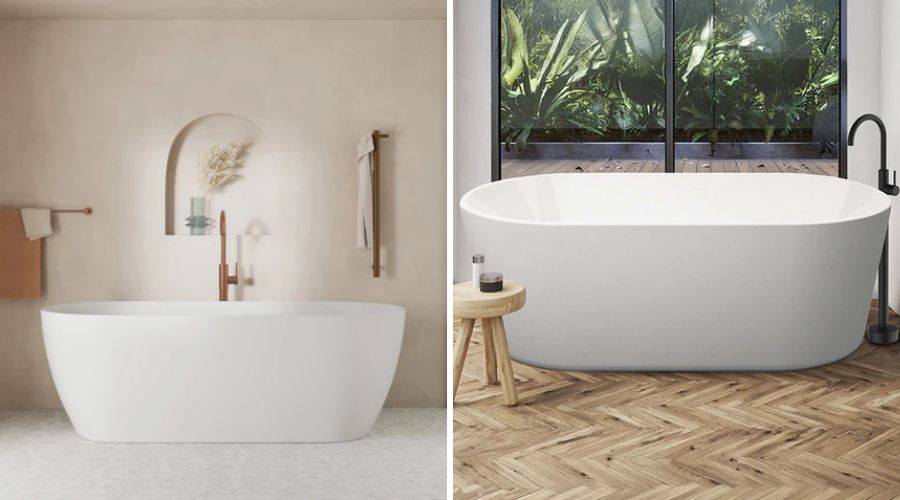Standard Bathtub Size Australia: Will It Fit in Your Bathroom?
Wondering if a standard bathtub will fit in your bathroom? This article breaks down common Australian bath sizes, types, layout tips, and what to do if space is tight.

If you’re renovating your bathroom or replacing an old tub, one of the first questions you’ll face is simple but important: will the bath actually fit? The good news is that most Australian homes can accommodate a standard bathtub, but that doesn’t mean every size will suit your space. This guide breaks down the most common bathtub dimensions, how to measure your bathroom, and what to do if a standard-size tub isn’t quite right for your layout.
The Fienza 1780mm solid surface bathtub is just above average size – ideal for large en-suites
What is the Standard Bathtub Size in Australia?
Most standard bathtubs in Australia measure around 1500mm to 1700mm in length, 700mm to 800mm in width, and 400mm to 450mm in height. These dimensions are designed to comfortably suit the average Aussie bathroom and user. If you’ve got a typical family bathroom, there’s a good chance one of these sizes will work.
Some freestanding baths and solid surface styles can go beyond 1800mm in length, but you’ll need a spacious layout to pull them off comfortably. You can also find small bathtubs, starting at around 1300m and designed to give you that soaking experience without crowding the room.
Types of Bathtubs and Their Standard Sizes
Different bath styles come with different dimensions. Some are made to maximise space. Others are built to make a statement. Here’s how they compare.
Built-in or inset bathtubs
Built-in or inset bathtubs are installed into a tiled frame or hob. They usually range from 1500mm to 1700mm and are popular for their space-efficient layout. You’ll often see them in family homes and apartment bathrooms.
Freestanding bathtubs
Freestanding bathtubs are finished on all sides and designed to be a centrepiece. Sizes usually start at 1500mm and can extend to 1800mm or more. They need extra space around them, so they’re best suited to bathrooms with room to breathe.
Corner bathtubs
Corner bathtubs are ideal for tricky layouts or small bathrooms where a traditional layout isn’t possible. Most are around 1400mm to 1500mm in length and make use of corner wall space without crowding the rest of the room.
Short or compact bathtubs
Short or compact bathtubs are usually 1300mm to 1500mm long and are perfect for ensuites or apartments. Despite the shorter length, many are deeper to give you that soak-worthy feel in a smaller footprint.
Shop the Decina 1700mm freestanding bathtub, suitable for most bathrooms
How to Measure Your Bathroom for a Bathtub
Before you fall in love with a bath, it’s worth measuring your space properly. The right measurements will help you avoid costly mistakes or awkward layouts.
Measure the available wall space
Start with the wall where you plan to install the bath. Note the total length and height, but also measure from the wall outwards so you understand how far the bath will project into the room.
Account for doors, windows and other fixtures
Check that your bath won’t block the door from opening fully or interfere with vanities, toilets or towel rails. If you’re placing a freestanding bathtub, you’ll also need to allow space around the edges, at least 50mm on each side for cleaning and access.
Check plumbing positions
Whether you're using an existing waste or planning to move it, knowing where the plumbing sits will influence your options. Built-in bathtubs are more forgiving here than freestanding styles.
Will a Standard Bathtub Fit in My Bathroom?
A standard bathtub, around 1500mm to 1700mm long, will fit most Australian bathrooms, but layout matters just as much as size.
Minimum room sizes
To comfortably fit a standard 1700mm bath, you’ll generally need a bathroom that’s at least 1800mm long on the wall where the bath sits. For smaller baths around 1500mm, a room length of 1650mm or more can work, depending on tapware and clearances.
Think beyond the floorplan
If your bathroom is narrow, L-shaped or has an awkward door position, you may be better off with a corner bathtub or compact bath that makes better use of the space.
Measure, plan, then shop
Sketch your layout and double-check every clearance, including space to stand up and move around. Even a beautiful bath can feel frustrating if it doesn’t work with your layout.
This 1500mm Fienza bathtub is a great option for smaller bathrooms
Space-Saving Alternatives to Standard Baths
If a full-size bath isn’t quite right, there are plenty of compact options that still give you comfort and functionality.
Small bathtubs
Small bathtubs start as small as 1300mm in length and are designed to give you a full soak without the full footprint. They’re a great option for powder room upgrades or small ensuites.
Corner options
Corner bathtubs are ideal if your bathroom is square or if you want to maximise an unused corner. They often give you more width and depth than a traditional tub in less linear space.
Shower-bath combos
Pairing a bath with a hand-held shower or dual shower set gives you two functions in one. If your bathroom doesn’t allow for separate zones, this can be a smart solution.
Best Tapware Pairings for Each Bath Type
Of course, your bathtub needs the right tapware pairing. Here’s an easy comparison table to help you decide.
|
Bath Type |
Recommended Tapware |
Why It Works |
|
Makes a visual statement and keeps the area around the bath clear. Ideal for open layouts. |
||
|
Saves space and simplifies cleaning. Keep your bath ledge clutter-free. |
||
|
Works well with tiled surrounds and hob-style setups. Offers a clean, built-in look. |
||
|
Allows flexible positioning, especially when plumbing is tight or off-centre. |
||
|
Lets you switch easily between soaking and showering, great for family bathrooms. |
Bathtub Installation Requirements and Common Mistakes
Allow room for access
If you're installing a freestanding bathtub, leave a minimum of 50mm to 100mm around the bath to allow for cleaning and access to plumbing. Back to wall bathtubs are more forgiving, as they sit flush against the wall.
Plan waterproofing early
All baths need to be properly waterproofed at the base and around any walls they touch. Built-in bathtubs will also need tiling or a bath hob to seal the space fully.
Watch your floor strength
Heavier styles, especially solid surface bathtubs, may need extra floor support, especially if you’re installing above ground level.
Avoid hidden traps
Make sure there’s access to the bath waste in case repairs are needed. Planning for maintenance now avoids headaches later.
Shop Premium Bathtubs at Buildmat
Whatever bathtub size you need, you’ll find it at Buildmat. Explore our most popular bathtub collections below.
- Explore all Buildmat bathtubs
- Shop freestanding baths
- Browse back to wall baths
- See corner bathtubs
- View solid surface baths
Looking for a specific look or brand? Explore bathware from trusted names like:
Looking for more? Check out our related bathtub articles:
- Matching Your Bathtub with Tapware: The Ultimate Style Guide
- Freestanding Bathtubs vs Drop-In Bathtubs
- How to Create a Spa-Like Retreat with Deep Bathtubs and Freestanding Bath Taps
Standard Bathtub Size FAQs
Do Australian bathtubs come in standard widths or just lengths?
Most standard bathtubs in Australia are between 700mm and 800mm wide, regardless of their length. However, some styles like freestanding bathtubs can be wider, while compact or inset bathtubs tend to stay narrower to save space.
Can I fit a bathtub into a wet room layout?
Yes, but it requires careful planning. If you’re combining a freestanding bath with an open shower zone, make sure drainage is properly graded and the entire room is waterproofed. Floor wastes and wall placement matter more in these layouts.
Is it better to choose a bath based on user height or bathroom size?
Both matter. If the space allows, taller users will be more comfortable in a bath that’s at least 1600mm long with a deeper interior. For families or households with mixed needs, something around 1500mm is often the best compromise. Browse small bathtubs or mid-size back to wall options if space is tight.
Are freestanding baths harder to install than inset ones?
Freestanding baths are often easier to position if your plumbing is already in place, but they require more clearance and may need extra support on upper floors. Inset bathtubs involve more tiling and waterproofing but work better in tight or multi-use layouts.
Can I install a bath against a window?
Yes, just make sure the window is properly sealed and made from a material that can handle moisture, like aluminium or uPVC. For a clean fit, back to wall baths work well in these setups.






























































































































































































































